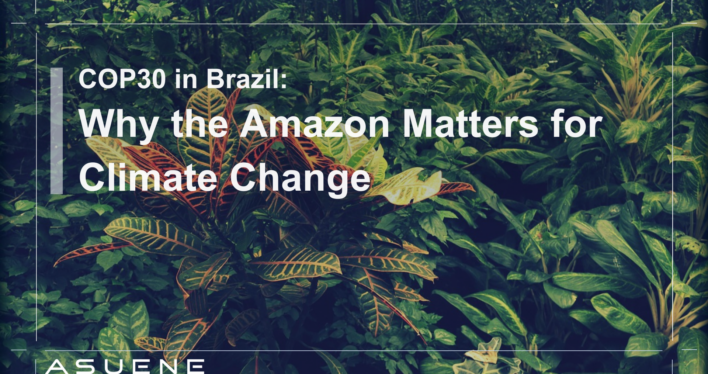- Article Summary
-
Introduction
In 2025, the world’s attention is turning to Brazil as it prepares to host COP30, the United Nations Climate Change Conference. This meeting, scheduled for November 2025 in Belém, is historically significant because it will take place in the heart of the Amazon rainforest. The Amazon, often called the ‘lungs of the planet,’ has historically absorbed around 5 percent of global carbon dioxide emissions each year, though this capacity is declining in some areas due to deforestation and climate stress. At a moment when the planet is racing against time to meet the 1.5°C target outlined in the Paris Agreement, the Amazon’s preservation has become central not only for Brazil’s climate diplomacy but also for global climate governance.
The Amazon is more than a regional environmental issue. Its forests, rivers, and biodiversity are globally connected. Destruction in this ecosystem has direct consequences for global carbon cycles, food systems, and indigenous communities who have acted as its guardians for centuries. COP30 represents a unique opportunity to realign international commitments with the Amazon’s protection, especially as Brazil seeks to position itself as a climate leader after years of political turbulence.
For many observers, COP30 could become a turning point. It is the first climate summit to be held in the Amazon itself, symbolically placing the rainforest at the center of negotiations. This creates momentum for governments, corporations, and civil society groups to translate scientific urgency into concrete policy.
The Amazon’s Role in Global Climate Stability
The Amazon rainforest covers more than 5.5 million square kilometers across nine countries, with Brazil holding about 60 percent of its area. It contains at least 10 percent of the world’s known biodiversity and stores roughly 150 to 200 billion metric tons of carbon in its vegetation and soils. Scientific studies have highlighted that if deforestation surpasses 20 to 25 percent of the Amazon’s area, the forest could reach a “tipping point,” shifting into a savanna-like ecosystem with catastrophic climate implications.
The Amazon’s role extends beyond carbon storage. It influences rainfall across Latin America, including agricultural regions in Brazil, Argentina, and Paraguay. It also affects the global water cycle, helping regulate weather patterns as far away as the United States and Europe. Thus, the Amazon is not merely a national resource but a planetary one.
Amazon’s Global Climate Contributions
| Contribution | Estimated Impact (Global) | Notes |
|---|---|---|
| Carbon absorption | ~2.2 billion tons CO₂/year (declining today) | Equivalent to ~5% of annual global emissions |
| Carbon stock in ecosystem | 150–200 billion tons | Nearly five times annual global emissions |
| Rainfall regulation | ~20% of global freshwater cycle | Impacts agriculture beyond South America |
| Biodiversity | ~10% of world’s species | Crucial for resilience and adaptation |
Despite its importance, deforestation rates in the Amazon surged during the last decade. Although Brazil has since taken steps to reverse the trend, significant challenges remain, especially with illegal logging, cattle ranching, and mining.
One striking example is cattle ranching, which accounts for about 80 percent of Amazon deforestation. The region has become a major supplier of beef to global markets. As demand continues, deforestation pressures grow. Another concern is illegal gold mining, which not only clears land but also contaminates rivers with mercury, threatening fish stocks and local communities. These drivers make clear that tackling Amazon deforestation requires not only environmental policy but also economic transformation.
Brazil’s Climate Diplomacy and COP30
Brazil has long been a central player in climate diplomacy. It was instrumental in shaping the Kyoto Protocol in the 1990s and has historically acted as a bridge between developed and developing countries. Hosting COP30 provides Brazil with an opportunity to rebuild credibility after years of setbacks in forest governance.
Under President Luiz Inácio Lula da Silva, Brazil has committed to eliminating illegal deforestation by 2030, aligning with global efforts under the Glasgow Leaders’ Declaration on Forests. The government has also reinvigorated partnerships with Norway and Germany through the Amazon Fund, channeling billions of dollars into conservation and sustainable development.
At COP30, Brazil is expected to focus on three critical themes:
- Forests & Nature-Based Finance: Brazil places forests at the heart of climate action, especially tropical rainforests like the Amazon. A central proposal is the Tropical Forests Forever Facility (TFFF), a performance-based, blended-finance fund meant to mobilize ≈ $125 billion and direct resources for forest conservation starting after COP30
- Scaling Up Climate Finance: Brazil is pushing the “Baku‑to‑Belém Roadmap”, aiming to ramp up climate finance from $300 billion to $1.3 trillion per year by 2035, combining public and private capital, and reforming financial institutions
- Circular & Nature-Based Solutions: Brazil is emphasizing the urgency of nature-based solutions, like regenerative agriculture and bioeconomy, to stay within the 1.5 °C warming limit.
Taken together, these proposals show that Brazil is positioning COP30 as a turning point, moving beyond deforestation pledges toward a broader climate agenda that blends environmental protection, financial transformation, and social inclusion. The country’s leadership will be tested on whether it can convert ambitious frameworks into binding agreements and secure global buy-in.

The Amazon as a Test Case for Global Cooperation
The Amazon demonstrates both the opportunities and limits of global climate cooperation. On the one hand, there is unprecedented recognition of its role in stabilizing the climate system. On the other hand, funding and enforcement mechanisms remain fragmented.
One of the central debates at COP30 will revolve around climate finance. Developing nations argue that wealthy countries must provide more resources to conserve forests that serve global public goods. Yet, current climate finance flows fall short of what is needed. According to the Climate Policy Initiative, only 3 percent of global climate finance is directed toward forests and land use, far below the levels required to prevent tipping points.
Another key issue is supply chain accountability. Major importers of commodities like soy, beef, and timber are under pressure to ensure that their supply chains are deforestation-free. New regulations in the European Union and California are already tightening standards, meaning that companies sourcing from the Amazon will face stricter oversight. Multinational corporations will have to improve traceability, invest in monitoring technologies such as satellite imaging, and collaborate with local producers to comply.
A positive sign comes from recent pilot initiatives. For example, Ecuador successfully launched a debt-for-nature swap in 2023, converting $1.6 billion of debt into conservation funding for the Galápagos Islands. Similar mechanisms are now being discussed for Brazil and neighboring countries. If scaled, these tools could unlock billions in new resources for forest protection.
Conclusion
COP30 in Brazil is not just another diplomatic milestone; it is a defining moment for the world’s climate future. The Amazon embodies the complexity of climate governance, where local realities intersect with global responsibilities. Protecting it requires more than pledges. It demands enforceable rules, adequate financing, and inclusive development pathways for those who depend on the forest for their survival.
The stakes are clear. If the Amazon tips into ecological collapse, the world’s ability to stabilize the climate system will be severely compromised. If, however, COP30 delivers ambitious commitments backed by real financial and political support, the Amazon can remain a living example of resilience.
Brazil’s stewardship of the Amazon at COP30 will test not only its own governance but also the world’s collective resolve. The success of this conference will be measured by whether the Amazon remains a thriving rainforest or becomes a cautionary tale of missed opportunity.
For global climate policy, the Amazon is no longer a side issue. It is the centerpiece of the 21st-century climate agenda, and COP30 may well decide its future.
Why Work with ASUENE Inc.?
Asuene is a key player in carbon accounting, offering a comprehensive platform that measures, reduces, and reports emissions. Asuene serves over 10,000 clients worldwide, providing an all-in-one solution that integrates GHG accounting, ESG supply chain management, a Carbon Credit exchange platform, and third-party verification.
ASUENE supports companies in achieving net-zero goals through advanced technology, consulting services, and an extensive network.


